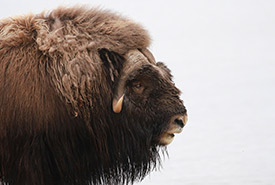
Muskox (Photo by camerondeckert, CC BY-NC 4.0)
Muskox
The Nature Conservancy of Canada (NCC) works across Canada, including the Arctic region. Here, NCC supports conservation through collaborative efforts with Indigenous communities and governments. The Arctic is crucial to countless species of wildlife, one of which is the muskox.
For thousands of years, muskox have lived in Canada’s coldest region. As climate change continues to melt ice caps and as the planet begins to warm, the muskox’s dependency on a cold climate is making its population vulnerable.
What does it look like?
Muskox lives in the Canadian Arctic for good reason. Thick, dark, fluffy hair covers it from head to rump. While visually similar to bison, muskox is genetically closer to sheep and goats. Both male and female muskox have prominent horns, curling up and out in a swooping “C” shape, though male horns are slightly larger. These huge animals are survivors of the ice age, with fossils from 90,000 years ago showing that muskox have always depended on frigid temperatures.
Where does it live?
Naturally occurring populations of muskox occur on the Arctic islands, Canada’s Northwest Territories and Nunavut. A small population has been introduced in Quebec and the Yukon as well. Though the majority of muskox are found in northern Canada, there are smaller populations in Alaska and Greenland due to translocations.
What is this species’ conservation status?
Muskox have been under protection by the Canada’s federal government since 1917. Prior to this, the introduction of European settlers/guns decreased the wild muskox population to the point of near extinction, but populations have increased. Currently, the only predator feeding on muskox is Arctic wolf. However, a rapidly increasing climate temperature could risk major changes to muskox populations. This species is also crucial to Inuit, who depend on the meat and wool as a vital resource: muskox fur is used for clothing, meat is used for food and horns are made into tools.
Arctic: an essential ecosystem
The Arctic is an essential ecosystem for regulating the planet’s temperature. Countless species rely on this region, including polar bear, Atlantic walrus, narwal and shark. This habitat is also one of the most vulnerable to due climate change. If Arctic ice caps continue to rapidly melt, this could result in rising sea levels, flooding and an increase in severe natural disasters.





